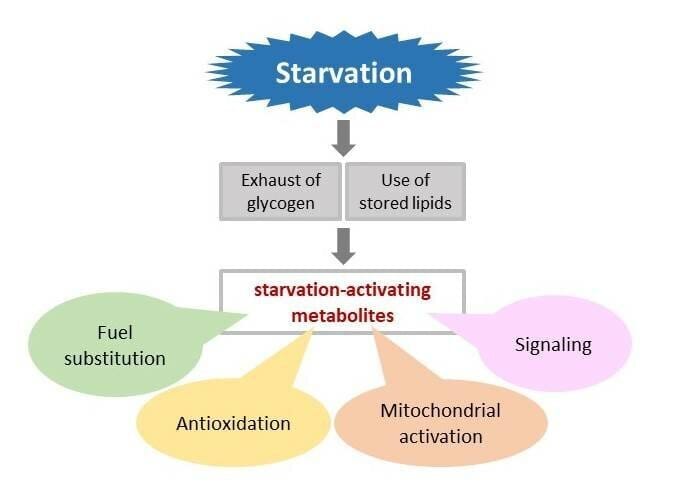Hey fitness nerds!
Thank you all {{active_subscriber_count}} of you!
Many believe fasting slows metabolism permanently.
After researching hundreds of studies and tracking my clients' results, I've discovered the surprising truth about how fasting affects our calorie burning.
Read 🔽 below!
⚡
IN LESS THAN 10 MINUTES WE WILL COVER:
Weekly Insights:
Fasting's Real Effect on Metabolism
Article Explained Simple: Understanding Yamanaka Factors
Top 3 Tests for Heart Health
High-Protein Vegan Dinner Recipe
Fasting's Real Effect on Metabolism
The relationship between fasting and metabolism proves more complex than commonly believed. Your body adapts to fasting differently than it does to regular calorie restriction.
During short-term fasting (up to 72 hours), metabolic rate actually increases slightly. This occurs through the release of norepinephrine, a hormone that promotes fat burning and maintains energy expenditure. Studies show metabolism can increase by 3-14% during this period.
After three days, metabolism begins adjusting. However, this adaptation protects muscle mass more effectively than standard calorie restriction. Fasting triggers autophagy, which recycles damaged cellular components rather than breaking down muscle for energy.
Your daily calorie burn changes during fasting, but not how most expect. The body becomes more efficient at using stored fat for fuel. This preserves lean tissue, which determines long-term metabolic rate.
Resting metabolic rate might decrease slightly during extended fasts, but this effect reverses quickly upon returning to normal eating. Studies show no long-term metabolic damage from intermittent fasting protocols.
Activity level matters more than fasting itself. People who maintain exercise during fasting periods show no significant drop in metabolism. The key lies in preserving muscle mass through proper protein intake when not fasting.
Hormonal changes during fasting actually support metabolism. Growth hormone increases significantly, which helps maintain muscle and bone mass. This prevents the metabolic slowdown seen in conventional dieting.
Remember, individual responses vary. Factors like body composition, activity level, and fasting duration all influence metabolic adaptation. Monitor your energy levels and adjust accordingly.

I will be adding more of these Diagram style pictures- I hope you find them more useful

Fitness and health enthusiasts - We have a lot of things in store for you!
Check out busybody.io - and join the waitlist for our brand-new AI health app.
Article of the Week
Article Explained Simple: Understanding Yamanaka Factors
Research reveals Yamanaka factors as powerful proteins that can reset cellular age.
These four factors (Oct4, Sox2, Klf4, and c-Myc) can reprogram adult cells back to a stem cell-like state. Scientists found partial activation of these factors can rejuvenate cells without losing their identity.
The study demonstrated improved function in aging human cells using this technology. This breakthrough suggests potential treatments for age-related diseases and improved tissue repair. However, precise control remains crucial as complete activation can cause tumour formation.
Fascinating Fact:
Yamanaka factors earned their discoverer, Shinya Yamanaka, the 2012 Nobel Prize in Medicine for revolutionizing our understanding of cellular aging and regeneration.
We have also started a referral program where you can earn prizes for referring your friends to this newsletter.
Top 3 Tests for Heart Health

Coronary Calcium CT
Coronary Calcium Score uses CT scanning to detect calcium buildup in heart arteries.
This test predicts heart attack risk years before symptoms appear.
Scores range from zero (optimal) to over 400 (high risk).Advanced Lipid Panel
Advanced Lipid Panel measures not just total cholesterol but particle sizes and inflammatory markers.
Small, dense LDL particles indicate higher risk than larger ones.
This test provides more detailed risk assessment than standard lipid panels.VO2 Max
VO2 Max Testing measures cardiovascular fitness directly.
This test reveals how efficiently your heart delivers oxygen during exercise.
Higher scores correlate with lower mortality risk and better heart function.
Vote below to choose the diet for next week’s recipe
High-Protein Vegan Dinner Recipe (makes 4 servings)
For my vegan friends. this one is for you.
This hearty lentil and mushroom loaf delivers impressive protein content without any animal products. After testing dozens of variations, I've perfected this recipe to satisfy even dedicated meat eaters.
The mushrooms provide a meaty texture while lentils ensure complete protein.
This recipe was created in 2 minutes with the BusyBody App. Click the button for free access to the app.

Macros per serving
Total Calories: 320 kcal
Protein: 22 g
Carbohydrates: 45 g
Sugars: 4 g
Fat: 8 g
The Ingredients
200g green lentils, dry (about 1 cup)
200g mushrooms, finely chopped
1 large onion, diced
3 cloves garlic, minced
100g rolled oats (1 cup)
60g ground flaxseed (1/2 cup)
2 tablespoons nutritional yeast
2 tablespoons tamari or soy sauce
1 tablespoon olive oil
1 teaspoon dried thyme
1 teaspoon smoked paprika
1/2 teaspoon black pepper Salt to taste
For the Glaze:
2 tablespoons tomato paste
1 tablespoon balsamic vinegar
1 tablespoon maple syrup
1 teaspoon tamari
The Instructions
Prepare Lentils: Rinse lentils and remove any debris. Cook in 3 cups water until tender, about 20 minutes. Drain well and slightly mash.
Cook Vegetables: Heat olive oil in large pan over medium heat. Sauté onions until translucent, about 5 minutes. Add mushrooms and garlic. Cook until moisture evaporates, about 10 minutes. Add seasonings and cook 2 minutes more.
Make Loaf Mixture: Mix cooked lentils with vegetable mixture. Add oats, flaxseed, and nutritional yeast. Season with tamari, salt, and pepper. Let rest 10 minutes to allow binding.
Prepare Glaze: Mix all glaze ingredients in small bowl.
Bake: Preheat oven to 375°F (190°C). Line loaf pan with parchment paper. Press mixture firmly into pan. Spread glaze evenly on top. Bake 45 minutes until firm. Let cool 10 minutes before slicing.
Serve with roasted vegetables or salad. Leftovers keep well refrigerated for up to 4 days.
Make your dream of working online a reality and start a newsletter - join beehiiv for free and don’t pay any renewal until you grow your subscriber base >2500 subscribers.
I’ve personally tried plenty of other platforms and Beehiiv is hands down the best and easiest to use.
What do you think about this week’s newsletter?
Reply to this email, and let us know how we can improve and if there are any topics you would like us to cover.

